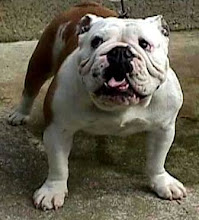In recent decades, Bulldogs are receiving much popularity as great show dogs. Due to their sweet-temperament and friendly attitude, they are truly adorable to many. Bulldogs are also referred to as English or British Bulldogs, and as their name implies, they are the symbol of elegance and tenderness. In earlier times, Bulldogs were mostly known as guard dogs. However, compared to the aggressive instinct of their ancestors, current breeds are much more mild-mannered and temperate. But under certain circumstances their fighting instinct becomes highly apparent.
In the year 1864 in England, the first Bulldog standard was documented and the standard was adopted in 1875. In 1890, the Bulldog Club of America was formed. Six years later, in the year 1896, the club adopted a new standard for Bulldogs. In 1914, the standard came under revision and the issue of the Dudley nose became rejected. However, in 1976, this rejection statement was once again reviewed and redefined as brown colored nose. In 1990, the standard was redesigned, however, keeping the words and terminologies intact.
As defined in specification, the standard Bulldogs must be of medium-sized and their entire body will be covered by smooth coat. Originally from England, these dogs are known for their short muzzle over a short-faced head. Dynamism, persistence and energy are the essential three qualities of a Bulldog. The standard size of the male adult and female adult are fifty pounds and forty pounds respectively. When you look straight at the dog, you can see that the eyes are positioned in the lower part of the skull area, while keeping a wider distance from the ears.
Loved for their friendliness, obedience and companionship, Bulldogs are known for their loyalty and occasional willfulness. They simply love being treated as family members and their attachment bond to the family is so high that they do not take even cross the yard without accompanied by the family members. These dogs have a sociable instinct and they can easily make friendships with children or dogs from other breeds. Typically they go well with other household animals as well. Occasionally, their level of intelligence comes under suspicion, but their true sense of obedience is simply unquestionable.
Typically Bulldogs experience different health complications throughout their lifetime. Breathing issues are mostly common among many Bulldogs, occurring as a result of the shortness of the muzzle. This causes Bulldogs to snore. Some Bulldogs are at risk for developing interstitial cysts, which occurs in-between the toes. Although this condition is curable with the help of experienced veterinarian, the dog experiences an extensive level of discomfort. Other common health problems are allergies, cherry eyes and hip-related problems.
A daily cleaning is mandatory for Bulldogs in order to keep them away from different infections caused as a result of moisturizer accumulation. By consulting with vet, a regular teeth brushing is also necessary. Like any other breeds, Bulldogs need to undergo through exercise schedules. Otherwise, they are at high risk for developing excessive weight, which may in turn lead to certain other complicated health problems, such as lung and heart disorders. Cleaning of their tail is also needed.
The Bulldog is an adorable dog with true elegance and gentleness. It is marked for its devotion and obedience to its master. If you are seeking basic Bulldog information, this article will provide it to you.
Sunday, April 27, 2008
Subscribe to:
Post Comments (Atom)

No comments:
Post a Comment